Climate change made Louisiana’s catastrophic floods much more likely

A study by the National Oceanic and Atmospheric Administration found human-derived rising temperatures increased the risk of the natural disaster by at least 40%

Climate change has radically increased the likelihood of the sort of torrential downpours that triggered ruinous floods in southern Louisiana last month, federal government scientists have said.
The National Oceanic and Atmospheric Administration (Noaa) said increasing global temperatures driven by human activity made the Louisiana floods, considered the worst natural disaster in the US since Hurricane Sandy in 2012, at least 40% more likely.
Nearly 7tn gallons of water was dumped on Louisiana in a week from 8 August, killing 13 people and flooding 60,000 properties, including the governors mansion. The repair bill is likely to be close to $9bn.
Scientists from Noaa and World Weather Attribution ran a statistical analysis of past rainfall and used two climate models to determine how heavy downpours have changed along the US gulf coast in the past 100 years. The experiment altered factors such as greenhouse gas levels to see how they correlate to extreme rainfall events.
We found human-caused, heat-trapping greenhouse gases can play a measurable role in events such as the August rains that resulted in such devastating floods, affecting so many people, said Karin van der Wiel, a research associate at Noaas Geophysical Fluid Dynamics Laboratory.
While we concluded that 40% is the minimum increase in the chances of such rains, we found that the mostly likely impact of climate change is a near doubling of the odds of such a storm.
Climate scientists have been reluctant to link the long-term warming trend to individual natural disasters or even single warm years. But growing understanding of the dynamics of the climate, and improved computer simulations, are starting to identify clear climate change fingerprints on short-term events.
Warmer air, influenced by heat-trapping gases released by human activity, contains more water vapor than cooler air. With extra heat helping to nourish storms, scientists expect global warming to help produce more intense downpours. The Louisiana flood was the eighth flood considered a once-every-500-years event to have taken place in the US in little more than 12 months.
Scientists undertook similar attribution work in January, a study finding that a record run of warm years this century was up to 130,000 times more likely to have occurred due to human interference.
The research, submitted to the journal Hydrology and Earth System Sciences Discussions, has yet to be peer-reviewed.
Michael Mann, a climatologist at Penn State University, said it was not possible to publish peer-reviewed research on the climate change influence of every event.
It leads to the fallacy that an event cannot have been influenced by climate change if some group of scientists havent published a peer-reviewed publication doing some sort of formal attribution exercise, Mann told the Guardian.
The Gulf of Mexico and Atlantic, like much of the worlds oceans, have been at record levels of warmth over the past several years. That means that there is more moisture for storms that form neighboring the Gulf, and of course that contributed to the record rainfall event in Louisiana.
We dont need a formal attribution study to tell us that. All we need is an appreciation of basic atmospheric physics.
Climate scientists not involved in the study praised it as a robust piece of work.
Its an excellent study, Columbia Universitys Adam Sobel told the Associated Press. The methods are appropriate and very thoroughly and clearly explained as are the assumptions necessary to draw the conclusions.
Read more: https://www.theguardian.com/science/2016/sep/08/climate-change-louisiana-floods-increased-risk